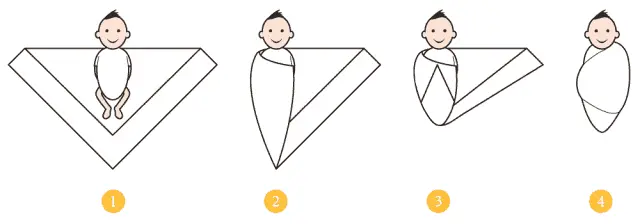For around 40 weeks your baby lives snug, warm, and confined in your womb. Swaddling, or the act of tightly wrapping your baby in a cloth or blanket, is thought to mimic this environment leading to comfort and even longer sleep periods while also preventing face scratching and startled wake-ups. This is why many hospitals and health care professionals now recommend swaddling newborns from birth to about one month of age. In fact, most newborns born in hospitals or birthing centers are swaddled for warmth and given to parents to hold before they are even bathed. If you, however, missed that important tutorial on how to swaddle a baby, this simple step-by-step guide has you covered from why and when to how in one snugly bundle.
The first step in any parenting task is to know the facts and decide if this is something you even want to do with your baby. Regardless of what doctors, hospitals, friends, family, the vast majority, or anyone else says, it’s important as a parent you know the risks and benefits of your actions and make the decision yourself.
The Benefits of Swaddling:
Not all of the following have been scientifically supported.
-Swaddled babies sleep longer as the wrapping prevents their movements from waking them.
-Swaddling prevents your baby from accidentally scratching him/herself.
-Swaddling helps very young babies regulate body temperature.
-Swaddling reduces the risk of SIDS as it helps reduce the amount of bedding needed to keep your baby warm, as well as prevents bedding from being able to fall or be pulled over your baby’s face.
-Swaddling can make breast feeding and holding easier by keeping your baby still and his/her hands and feet out of the way.
-Swaddling can help prevent over stimulation which can lead to more crying.
-Swaddling is soothing to some babies as it is said to have a similar feeling to the womb.
The Risks of Swaddling:
Though the risks of swaddling are few, all are supported by research.
-Swaddling can lead to over-heating.
-Excessive swaddling can cause problems such as hip dysplasia with joints.
-Swaddling may increase the risk of pneumonia and other respiratory issues.
-Excessive swaddling may reduce motor development as it limits movements.
The risks of swaddling may be reduced by limiting how long your baby is swaddled and keeping the wrap looser on the legs.
When to Swaddle:
A baby should not be swaddled all the time. Swaddling is best used during naps, sleep-time, feeding and any time your baby needs extra comfort.
Some experts feel a baby should not be swaddled past one month in age as it may hinder development due to the restriction of hand and foot movements. Others feel swaddling is okay to about three or four months of age as long as swaddled-time is limited. Most pediatricians recommend tummy and play time for all babies to aid in development. Leaving an infant to lay swaddled on it’s back excessively is thought to negatively affect respiratory health as well, and so is not recommended.
Some babies don’t take well to swaddling from the start and others enjoy it. How long you swaddle your baby and how often will be personalized based on your baby and your needs, just remember not to do so excessively.
In any case, appropriate blankets should be used based on temperature conditions. In warmer temperatures, very light cloth should be used and swaddling should be kept minimal. In colder temperatures, warmer blankets are acceptable.
Now that you know the why and the when of how to swaddle a baby, the final step is to swaddle your baby.
How to Swaddle a Baby:
1-Lay down your chosen blanket or cloth for swaddling in a diamond shape and fold the top right corner down about six inches. Gently Place your baby on the blanket with the fold behind his/her head.
2-Pull one side of the blanket across your baby’s body and tuck behind the opposite arm. Be sure to do so securely, but not so tight it hinders circulation.
3-Pull the bottom corner of the blanket up towards your baby’s chin. If it’s too long bring it over one shoulder and tuck it behind your baby.
4-Pull the remaining corner of the blanket across your baby’s chest and tuck it into the other side of your wrap. Check to be sure wrap is secure and not overly tight, especially on the legs and hips.
You may also swaddle below rather than above the arms to leave your baby’s arms free.
This may take a little practice, but is easy once you have it down. You can even purchase cheater swaddling blankets that are pre-cut with Velcro straps to hold the swaddle in place.


